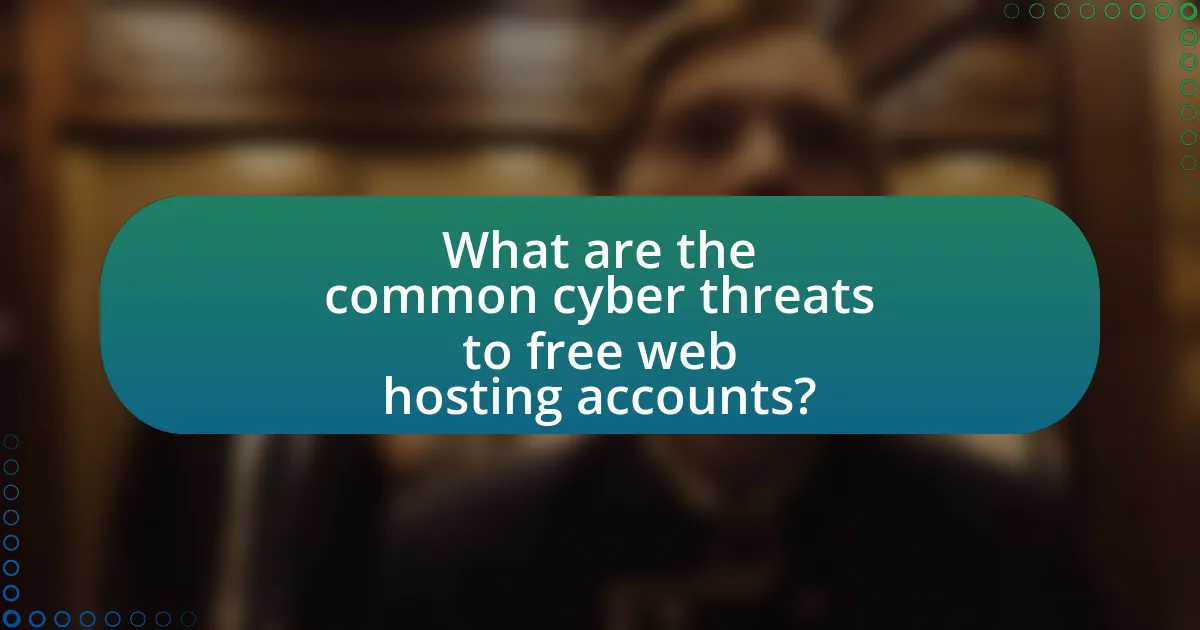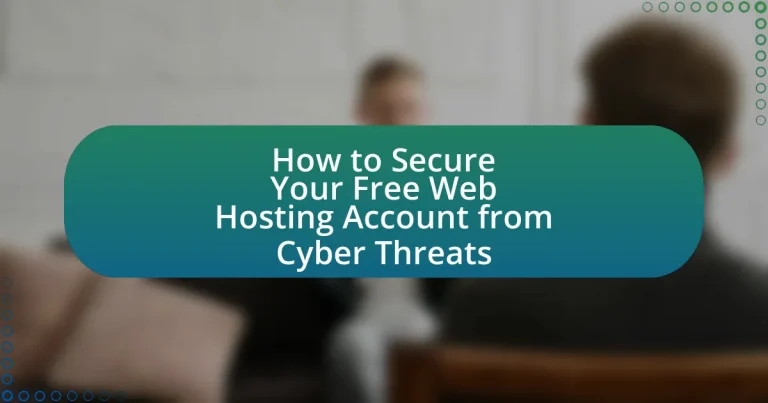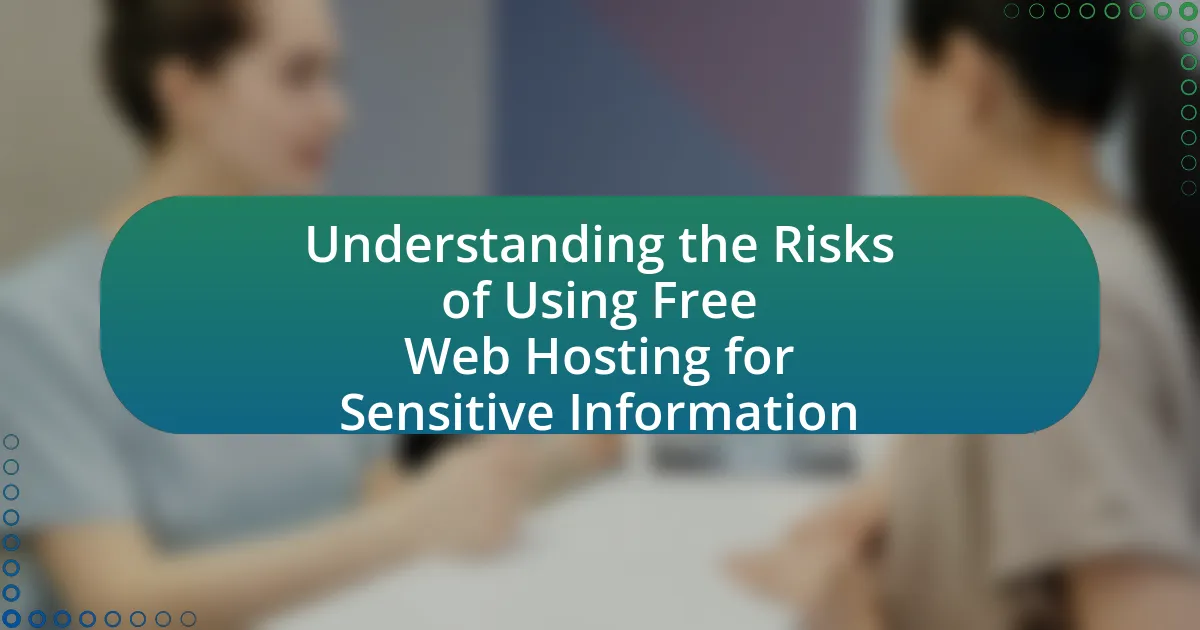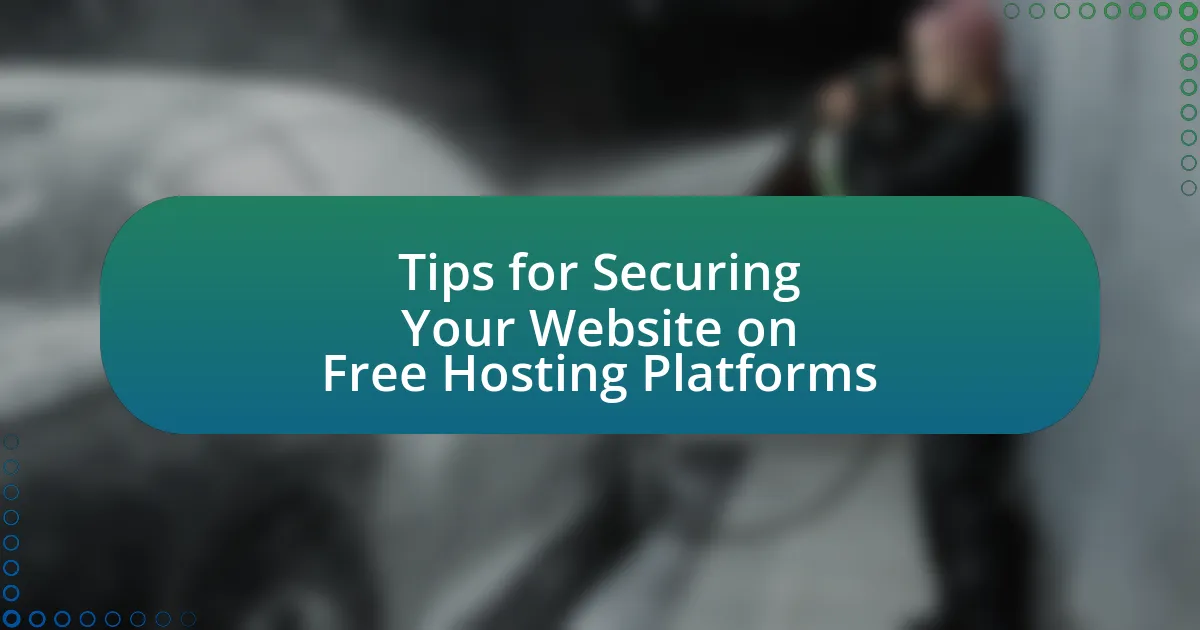The article focuses on securing free web hosting accounts from various cyber threats, including malware infections, phishing attacks, and data breaches. It highlights how hackers exploit vulnerabilities in free hosting services due to weak security configurations and outdated software. The prevalence of attacks such as phishing, malware injection, and denial-of-service is discussed, along with the specific risks associated with free hosting accounts. The article also outlines essential security measures, including the implementation of strong passwords, two-factor authentication, regular updates, and backups, as well as recommended security plugins and monitoring tools to enhance protection against cyber threats.

What are the common cyber threats to free web hosting accounts?
Common cyber threats to free web hosting accounts include malware infections, phishing attacks, and data breaches. Malware can be injected into websites hosted on free platforms, compromising user data and site functionality. Phishing attacks often target users of free hosting services, tricking them into revealing sensitive information. Data breaches can occur due to inadequate security measures in free hosting environments, exposing personal and financial information. According to a 2021 report by Cybersecurity Ventures, 60% of small businesses that experience a cyber attack go out of business within six months, highlighting the critical need for robust security measures in free web hosting.
How do hackers exploit vulnerabilities in free web hosting services?
Hackers exploit vulnerabilities in free web hosting services primarily through weak security configurations and outdated software. Many free hosting providers lack robust security measures, making it easier for attackers to gain unauthorized access. For instance, they may use SQL injection attacks to manipulate databases or cross-site scripting (XSS) to execute malicious scripts in users’ browsers. According to a report by the Ponemon Institute, 60% of small businesses that use free hosting services experience security breaches due to inadequate protections. This statistic underscores the prevalence of vulnerabilities in such platforms, highlighting the need for users to implement additional security measures to safeguard their accounts.
What types of attacks are most prevalent against free web hosting accounts?
The most prevalent types of attacks against free web hosting accounts include phishing, malware injection, and denial-of-service (DoS) attacks. Phishing attacks target users by impersonating legitimate services to steal credentials, while malware injection involves inserting malicious code into websites hosted on free platforms, often exploiting vulnerabilities in the hosting service. Denial-of-service attacks overwhelm the server with traffic, rendering the website inaccessible. According to a report by the Cybersecurity & Infrastructure Security Agency, free hosting services are particularly vulnerable due to their limited security measures, making them attractive targets for cybercriminals.
How can phishing attacks specifically target free web hosting users?
Phishing attacks can specifically target free web hosting users by exploiting the lack of security measures and the perceived anonymity associated with free services. Attackers often create fake websites that mimic legitimate free hosting platforms, tricking users into entering sensitive information such as login credentials. According to a report by the Anti-Phishing Working Group, 74% of phishing sites are hosted on free web hosting services, highlighting the vulnerability of these platforms. Additionally, free web hosting users may be less vigilant about security practices, making them more susceptible to social engineering tactics employed in phishing schemes.
Why are free web hosting accounts more susceptible to cyber threats?
Free web hosting accounts are more susceptible to cyber threats due to limited security measures and resources provided by hosting services. These accounts often lack essential features such as robust firewalls, regular security updates, and dedicated customer support, making them attractive targets for hackers. According to a study by the Cybersecurity & Infrastructure Security Agency, free hosting services are frequently exploited because they do not invest in advanced security protocols, leaving users vulnerable to malware, phishing attacks, and data breaches.
What limitations do free web hosting services impose that increase risk?
Free web hosting services impose several limitations that increase risk, including lack of security features, limited bandwidth, and absence of customer support. These services often do not provide essential security measures such as SSL certificates or firewalls, making websites vulnerable to cyber attacks. Additionally, limited bandwidth can lead to performance issues, which may result in downtime or unavailability during traffic spikes, further exposing the site to risks. The absence of reliable customer support means that users may struggle to resolve security issues promptly, leaving their sites exposed for longer periods.
How does the lack of security features in free hosting affect users?
The lack of security features in free hosting significantly increases users’ vulnerability to cyber threats. Without essential protections such as SSL certificates, firewalls, and regular security updates, users are at a higher risk of data breaches, hacking, and malware infections. For instance, a study by the Ponemon Institute found that 60% of small businesses that experience a cyber attack go out of business within six months. This statistic underscores the critical need for robust security measures, which are often absent in free hosting services, leaving users exposed to potential financial and reputational damage.

What steps can you take to secure your free web hosting account?
To secure your free web hosting account, implement strong passwords and enable two-factor authentication. Strong passwords should be at least 12 characters long, combining letters, numbers, and symbols, which significantly reduces the risk of unauthorized access. Two-factor authentication adds an extra layer of security by requiring a second form of verification, such as a code sent to your mobile device, making it harder for attackers to gain access even if they have your password. Additionally, regularly update your software and plugins to patch vulnerabilities, as outdated systems are prime targets for cyber threats.
How can strong passwords enhance the security of your account?
Strong passwords enhance the security of your account by making it significantly more difficult for unauthorized users to gain access. A strong password typically includes a combination of uppercase and lowercase letters, numbers, and special characters, which increases the number of possible combinations an attacker must guess. According to a study by the National Institute of Standards and Technology (NIST), passwords that are at least 12 characters long and include a mix of character types can take years or even centuries to crack using brute-force methods. This level of complexity deters cyber threats, as attackers often rely on common or easily guessable passwords. Therefore, implementing strong passwords is a critical step in safeguarding your online accounts against unauthorized access.
What are the characteristics of a strong password?
A strong password is characterized by its length, complexity, and unpredictability. Specifically, it should be at least 12 to 16 characters long, incorporating a mix of uppercase letters, lowercase letters, numbers, and special symbols. This combination significantly increases the number of possible password combinations, making it more resistant to brute-force attacks. Research indicates that passwords with these characteristics can take years or even centuries to crack using current technology, thereby enhancing security against unauthorized access.
How often should you change your password for optimal security?
For optimal security, you should change your password every three to six months. This frequency helps mitigate the risk of unauthorized access, as it limits the time an attacker can exploit a compromised password. Research from the National Institute of Standards and Technology (NIST) indicates that regular password changes can significantly enhance account security, especially when combined with strong, unique passwords for each account.
What role does two-factor authentication play in securing your account?
Two-factor authentication (2FA) significantly enhances account security by requiring two forms of verification before granting access. This additional layer of security mitigates the risk of unauthorized access, as even if a password is compromised, the account remains protected unless the second factor, typically a code sent to a mobile device or generated by an authentication app, is also obtained. According to a study by Google, implementing 2FA can block 100% of automated bots and 96% of targeted attacks, demonstrating its effectiveness in safeguarding accounts against cyber threats.
How can you enable two-factor authentication on your free hosting account?
To enable two-factor authentication on your free hosting account, access your account settings and locate the security or two-factor authentication section. Many hosting providers offer a straightforward setup process, often requiring you to link a mobile authentication app, such as Google Authenticator or Authy, to your account. Once linked, you will receive a verification code on your mobile device each time you log in, adding an extra layer of security. This method is widely recognized for enhancing account protection against unauthorized access.
What are the benefits of using two-factor authentication?
Two-factor authentication (2FA) significantly enhances security by requiring two forms of verification before granting access to an account. This additional layer of security reduces the risk of unauthorized access, as even if a password is compromised, the second factor—such as a text message code or authentication app—remains secure. According to a study by Google, implementing 2FA can block 99.9% of automated attacks, demonstrating its effectiveness in protecting sensitive information and accounts from cyber threats.

What best practices should you follow to maintain security over time?
To maintain security over time, regularly update software and systems, implement strong password policies, and conduct routine security audits. Regular software updates patch vulnerabilities, reducing the risk of exploitation; for instance, the 2020 Microsoft Exchange Server vulnerabilities highlighted the importance of timely updates. Strong password policies, including the use of multi-factor authentication, significantly decrease unauthorized access, as studies show that 81% of data breaches are linked to weak passwords. Routine security audits help identify and mitigate potential threats, ensuring that security measures remain effective against evolving cyber threats.
How can regular updates and backups protect your web hosting account?
Regular updates and backups protect your web hosting account by ensuring that software vulnerabilities are patched and that data can be restored in case of loss. Updates frequently address security flaws that cyber attackers exploit; for instance, a study by the Ponemon Institute found that 60% of data breaches are linked to unpatched vulnerabilities. Backups provide a safety net, allowing users to recover their website and data quickly after incidents like hacking or server failures, minimizing downtime and data loss. Regularly implementing these practices significantly enhances the security posture of a web hosting account.
What should you include in your backup strategy?
A comprehensive backup strategy should include regular automated backups, multiple backup locations, and data encryption. Regular automated backups ensure that data is consistently saved without manual intervention, reducing the risk of data loss. Utilizing multiple backup locations, such as local storage and cloud services, provides redundancy, ensuring data is recoverable even if one location fails. Data encryption protects sensitive information during storage and transfer, safeguarding it from unauthorized access. These elements are critical for maintaining data integrity and security against cyber threats.
How often should you perform updates and backups?
You should perform updates at least once a month and backups weekly. Regular updates ensure that your software is protected against the latest vulnerabilities, as cyber threats evolve rapidly. According to a study by the Cybersecurity & Infrastructure Security Agency, timely updates can reduce the risk of exploitation by up to 85%. Weekly backups safeguard your data, allowing for recovery in case of data loss or breaches. The National Cyber Security Centre recommends frequent backups to minimize potential data loss and ensure business continuity.
What tools and resources can help you monitor your account’s security?
To monitor your account’s security, utilize tools such as security information and event management (SIEM) systems, intrusion detection systems (IDS), and two-factor authentication (2FA) applications. SIEM systems, like Splunk or LogRhythm, aggregate and analyze security data from various sources, enabling real-time threat detection. IDS tools, such as Snort or OSSEC, monitor network traffic for suspicious activity, providing alerts on potential breaches. Additionally, 2FA applications, like Google Authenticator or Authy, add an extra layer of security by requiring a second form of verification during login, significantly reducing the risk of unauthorized access. These tools collectively enhance your ability to detect and respond to security threats effectively.
Which security plugins are recommended for free web hosting accounts?
Recommended security plugins for free web hosting accounts include Wordfence Security, Sucuri Security, and iThemes Security. Wordfence Security offers a comprehensive firewall and malware scanner, making it effective for protecting websites from various threats. Sucuri Security provides security activity auditing, file integrity monitoring, and remote malware scanning, which are crucial for maintaining website integrity. iThemes Security focuses on strengthening user credentials and preventing brute force attacks, enhancing overall security. These plugins are widely recognized for their effectiveness in safeguarding websites hosted on free platforms.
How can you use monitoring services to detect suspicious activity?
Monitoring services can be used to detect suspicious activity by continuously analyzing network traffic, user behavior, and system logs for anomalies. These services employ algorithms and machine learning techniques to identify patterns that deviate from normal operations, such as unusual login attempts, unexpected data transfers, or unauthorized access to sensitive files. For instance, a study by the Ponemon Institute found that organizations using continuous monitoring were able to detect breaches 27% faster than those relying on traditional methods. This rapid detection capability is crucial for mitigating potential threats and securing web hosting accounts from cyber threats.
What are the common troubleshooting steps if you suspect a security breach?
If you suspect a security breach, the common troubleshooting steps include isolating the affected systems, analyzing logs for unusual activity, changing passwords, and notifying relevant stakeholders. Isolating systems prevents further unauthorized access, while log analysis helps identify the breach’s nature and extent. Changing passwords secures accounts against potential misuse, and notifying stakeholders ensures that all parties are aware of the situation and can take necessary precautions. These steps are critical in mitigating damage and restoring security.
How can you identify signs of a compromised account?
You can identify signs of a compromised account by monitoring for unusual activity, such as unauthorized logins, unexpected password changes, or unfamiliar transactions. These indicators suggest that someone may have gained access to the account without permission. For instance, a report from the Cybersecurity & Infrastructure Security Agency (CISA) highlights that 60% of users experience unauthorized access at some point, emphasizing the importance of vigilance. Additionally, receiving alerts about login attempts from unfamiliar locations or devices can further confirm potential compromise.
What immediate actions should you take if your account is breached?
If your account is breached, immediately change your password to prevent further unauthorized access. This action is crucial because a strong, unique password can significantly reduce the risk of continued exploitation. Next, enable two-factor authentication (2FA) if available, as it adds an additional layer of security by requiring a second form of verification. Additionally, review your account activity for any unauthorized transactions or changes, and report these to your service provider. Finally, scan your devices for malware to ensure that no malicious software is compromising your security. These steps are essential in mitigating damage and securing your account against future breaches.




